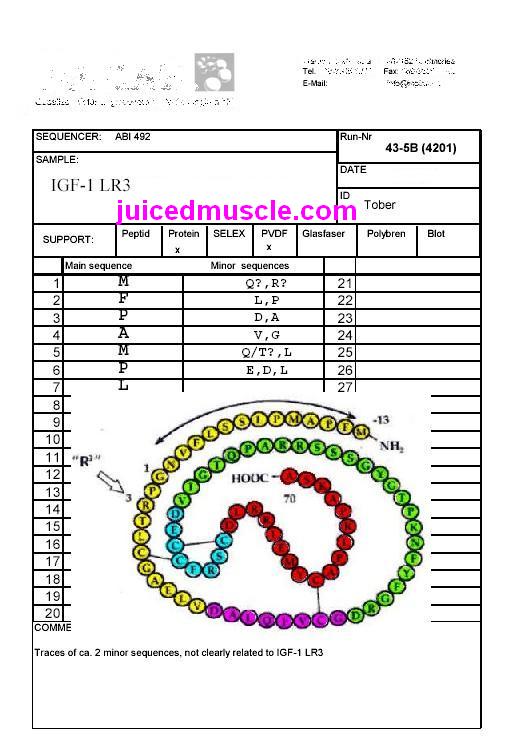And an Other (bad) Chinese IGF-1 LR3 sample
.JPG)
It turned out it was a very dangerous item that contained ratinsulin instead of IGF-1 LR3!!
When we started to analyse a new sample we bought in China, we found it was IGF-1 this time.
However, we also found two problems:
1) The protein is heterogeneous as can be seen in the MALDI-MS spectrum.
2) The N-terminus could not be resolved by the peptide mass fingerprint using Asp-N. We could cover the sequence from residue 58-83, but not from 1-57.
Therefore, we could not exclude that the N-terminus might be modified somehow.
Since we where sure that the C-terminus is intact it might be helpful to analyse the N-terminal sequence of the protein by Edman degradation. This could probably explain the heterogeneity of the protein.
.JPG)
Now we had shown that N- and C-terminus of the protein are okay. Some problems remain: we could not explain the heterogeneity of the protein in MALDI-MS.
Second, we did not see two expected N-terminal peptides in the peptide mass fingerprint which is a clear indication that there are exchanges in the sequence.
It is difficult to speculate what happened exactly with the IGF-1.
Based on the mass detection by MALDI-MS one can conclude that it does not contain the exact sequence, and since the complete C-terminus was explained, this deviation must be in the N-terminal region (not at the N-terminus as proven by Edman sequencing).
If we would use other enzymes for fragmentation and MALDI-MS/MS for identification of the unexplained peptides we probably would be able to identify the whole sequence. However, this would cost much more money. And since we where already able to prove that this sample was not a pure and a therefore active product, we decided to let it be.
We asked the laboratory in Germany to run a SDS-PAGE also and it turned out that the sample was not polluted.
We also asked them to look for BSA. Since we knew that BSA is added to many protein solutions (e.G. antibodies) for stabilization. However, these are NOT drugs used in human! But we know that Underground Labs also buy cheap BSA (bovine serum albumin) polluted peptides and sell this to their customers. Like most of you will know, most peptides (growth hormones - IGF-1 Lr3 – pegylated growth factors etc) are sold in a lyphosized form (a freeze dried pressed crust of dry powder) in a small bottle, mostly with a blue cap. It is therefore impossible to say who originally manufactured this bottle.
But we did not see any high molecular components like bovine (cattle) albumin in this sample, as can be seen in the SDS-PAGE
Again we want to thank Dr. Thomas Halder from Germany for his help and explanation.
When a peptide is digested it falls apart in different parts (called peptide fragments. )These fragments are numbered (and coloured by us) after the number you see the number of amino acids of this particular fragment then its molecular mass (or molecular weight) and then the different amino acids.
- Login to post comments



